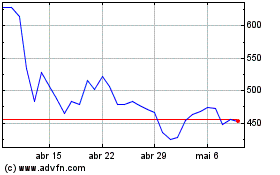This Bitcoin Halving May Not Result In Supply Squeeze: Glassnode
22 Março 2024 - 1:00PM
NEWSBTC
Glassnode has suggested that the upcoming Bitcoin halving might not
result in a supply squeeze that the market may have anticipated.
Bitcoin Halving May Not Carry Same Impact Due To Spot ETFs In a new
report, the on-chain analytics firm Glassnode has discussed the
impact the next Bitcoin halving may have on the economics of the
cryptocurrency. The “halving” is a periodic event for BTC where its
block rewards (the rewards the miners receive for adding blocks on
the network) are permanently cut in half. Related Reading: Bitcoin
Cash (BCH) Surges 15% As Coinbase Plans Futures Listing This event
is built into the coin’s code, meaning it happens automatically.
The halving kicks in after every 210,000 blocks, or approximately
every four years. The next such event will take place sometime in
the coming month. Historically, the halving has been considered an
important event for the asset due to how it influences its supply
dynamics. The block rewards the miners receive are the only way to
introduce new BTC tokens into circulation. Since they get tightened
during these events, the cryptocurrency’s production rate slows
down following them. As such, halvings are considered bullish
events, with the price increasing following them due to the
constrained supply, as supply-demand dynamics would dictate.
“However, the current market conditions differ from historical
norms,” says Glassnode. The reason behind that is simple; there is
something now that was never there in the past: the spot
exchange-traded funds (ETFs). Spot ETFs are investment vehicles
that buy and hold Bitcoin and allow their users to gain indirect
exposure to the cryptocurrency’s price action through them. Since
the spot ETFs are available on traditional exchanges, they can be
preferable for those not looking to dabble with digital asset
platforms and wallets. Thus, the ETFs have introduced a notable
amount of fresh demand for the asset, with supply rapidly leaving
the market and entering these funds. To put this demand into
perspective, the analytics firm has compared it against the BTC
amount miners issue on the chain daily. The trend in the spot ETF
flows and miner issuance since the start of the year | Source:
Glassnode As the above chart shows, the Bitcoin ETF flows have
generally been much higher than what the miners have been
introducing into circulation. Based on this, Glassnode believes
“the upcoming halving might not result in the supply squeeze once
anticipated.” Related Reading: Bitcoin Traders Capitulate: Here’s
What Happened Last 2 Times The report further says: The ETFs are,
in essence, preempting the halving’s impact by already tightening
the available supply through their substantial and continuous
buying activity. In other words, the supply squeeze usually
expected from halvings may already be in effect due to ETFs’
large-scale bitcoin acquisitions. Something to note, however, is
that the ETFs aren’t certain to always be a bullish influence for
the market. Should the current inflow-heavy regime flip to one
dominated by outflows, the cryptocurrency could naturally witness
extraordinary selling pressure. In fact, the spot ETF netflows have
been negative for Bitcoin for four straight days now, so such a
trend shift may already be in action. BTC Price Bitcoin had
recovered beyond the $68,000 level yesterday, but the coin has
since declined again, falling back towards $64,200. Looks like the
price of the asset has has retraced a chunk of its recovery |
Source: BTCUSD on TradingView Featured image from Traxer on
Unsplash.com, Glassnode.com, chart from TradingView.com
Bitcoin Cash (COIN:BCHUSD)
Gráfico Histórico do Ativo
De Dez 2024 até Jan 2025

Bitcoin Cash (COIN:BCHUSD)
Gráfico Histórico do Ativo
De Jan 2024 até Jan 2025
